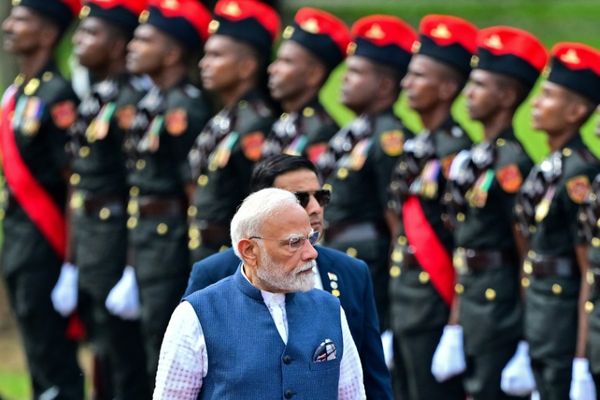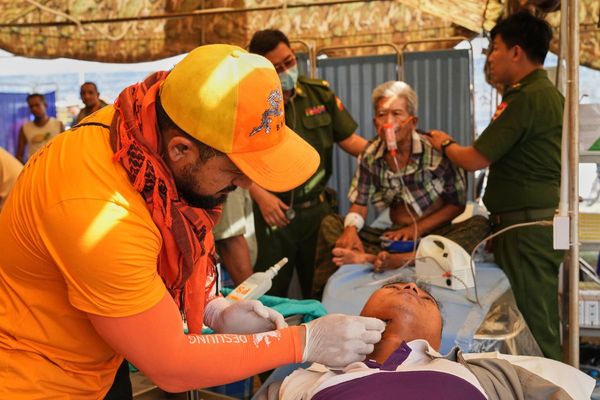NEW DELHI: The 2023 Asian Games on Sunday concluded with a spectacular closing ceremony in Hangzhou, celebrating the incredible achievements of the athletes and showcasing China's rich cultural heritage.
The 'Big Lotus' Stadium, packed with 80,000 spectators, was transformed into a mesmerizing display of lights, sounds, and lasers during the 75-minute extravaganza.
Athletes from 45 participating countries bid farewell after over two weeks of fierce sporting competition. The closing ceremony was a vibrant fusion of sports and culture, aiming to bring together the worlds of athleticism and artistry in perfect harmony.
Olympic Council of Asia (OCA) acting chief Randhir Singh declared the 19th edition of the Asian Games closed in the presence of Chinese premier Li Qiang and other dignitaries.

(Reuters photo)
"I declare the 19th Hangzhou Asian Games closed and as per the tradition call upon the youth of Asia to assemble in three years time in Aichi-Nagoya (Japan) to celebrate the 20th Asian Games there in accordance with the ideals of the Olympic Council of Asia.
"May the youth of Asia ever celebrate the Asian Games in the spirit of brotherhood and for the good of humanity," Singh said.
"Over the past 16 days, we have shared many unforgettable moments in this magnificent city. And it is time to say 'Shay Shay, Hangzhou' for a wonderful and memorable Asian Games," said the veteran administrator.
"Asia and the world loves Hangzhou! You have been the perfect host – and the OCA will never forget this. I would like to thank the Chinese Government, the Chinese Olympic Committee, the people of Hangzhou and HAGOC for what you have done and ensured that the Hangzhou Asian Games were an unprecedented success."
The biggest Asian Games ever was brought to an end with China dominating the medals table once again, the 201 gold (along with 111 silver and 71 bronze) beating the 199 they collected at 2010 Guangzhou Games.
Japan (52 gold, 67 silver, 69 bronze) and South Korea (42 gold, 59 silver, 89 bronze) were second and third with India finishing at fourth with a record haul of 107 medals (28 gold, 38 silver, 41 bronze).
Thirteen world records, 26 Asian records and 97 Games records were broken during the Games, according to OCA acting director general Vinod Kumar Tiwari.
The stadium saw less attendance than the opening ceremony on September 23 but the crowd joined the athletes and volunteers.

(Reuters photo)
The flag bearers of all the countries came out first before the other athletes and officials joined. Men's hockey team goalkeeper PR Sreejesh was the Indian flag bearer.
There were around 100 Indian athletes and officials in the parade, as many of them had already left for home after the end of their respective events.
The organisers said 12,407 athletes from 45 nations competed in 40 sports at the Hangzhou Games, which were delayed by a year due to the COVID-19 pandemic.
In a sombre ceremony, the torch and flag of the first Asian Games in New Delhi in 1951 as well as the OCA flag was handed to the governor of Japan's Nagoya-Aichi, the 2026 edition host city.

(AP photo)
For the cultural programme, the giant oval-shaped LED floor screen that gave naked-eye 3D visual effects during the opening ceremony was not used. Instead, a 'digital turf' -- said to be the first of its kind used in Asian Games -- transformed the football pitch into an evocative garden with big cut outs of separate letters of 'Asia' at the side.
The 'digital turf', which is the fusion of technology and ecology, and the grafting of technology and art, was a large mesh with over 40,000 illuminated spots evenly woven in, covered the football field to turn it into a giant colour palette, where shifting images, such as starry skies, flowers and waves, were displayed in a glittering way.
A memory river flowed across the stage toward the end of the show, reflecting on all the hard work and thoughtful services provided by volunteers during the Games, before welcoming them to join the athletes in the final celebration.
The giant virtual torchbearer, who lit up the main Games flame together with Olympic champion — and 19th Asian Games gold medallist — swimmer Wang Shun at the opening ceremony, returned to witness the flame being extinguished, together with the volunteers and athletes.
The digital giant then bid his own farewell with an emotional gesture before disappearing from the show.
The main theme of the ceremony was the 'Enduring Memories of Hangzhou' with the carnival conveying the timeless friendship of 'Flowers for Parting Friends' and the aspiration of 'The Lotus and the Osmanthus in Harmony'.
The Lotus and the Osmanthus in Harmony depicted the thousand-year tradition between parting friends and adapted this tradition in the realm of sports and competition.
Osmanthus is one of the most important flowers in China and the city flower of Hangzhou. It is associated with the Moon and is said to have magical self-healing powers.
The ceremony aimed at showcasing the exciting and touching moments of athletes throughout the Games, while representing millions of volunteers and citizens of Hangzhou as well as every person that made these Games possible.
By focusing on the people, it sought to highlight the people-to-people interactions and the spirit of Sports Without Borders.
(With inputs from PTI)







